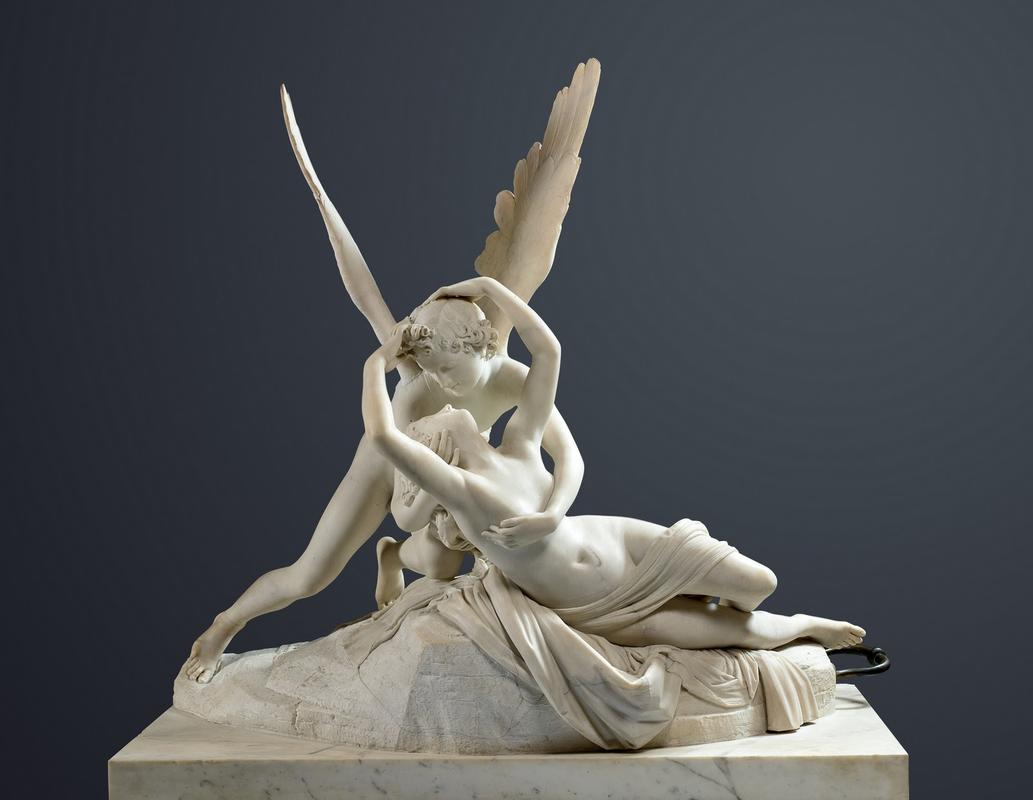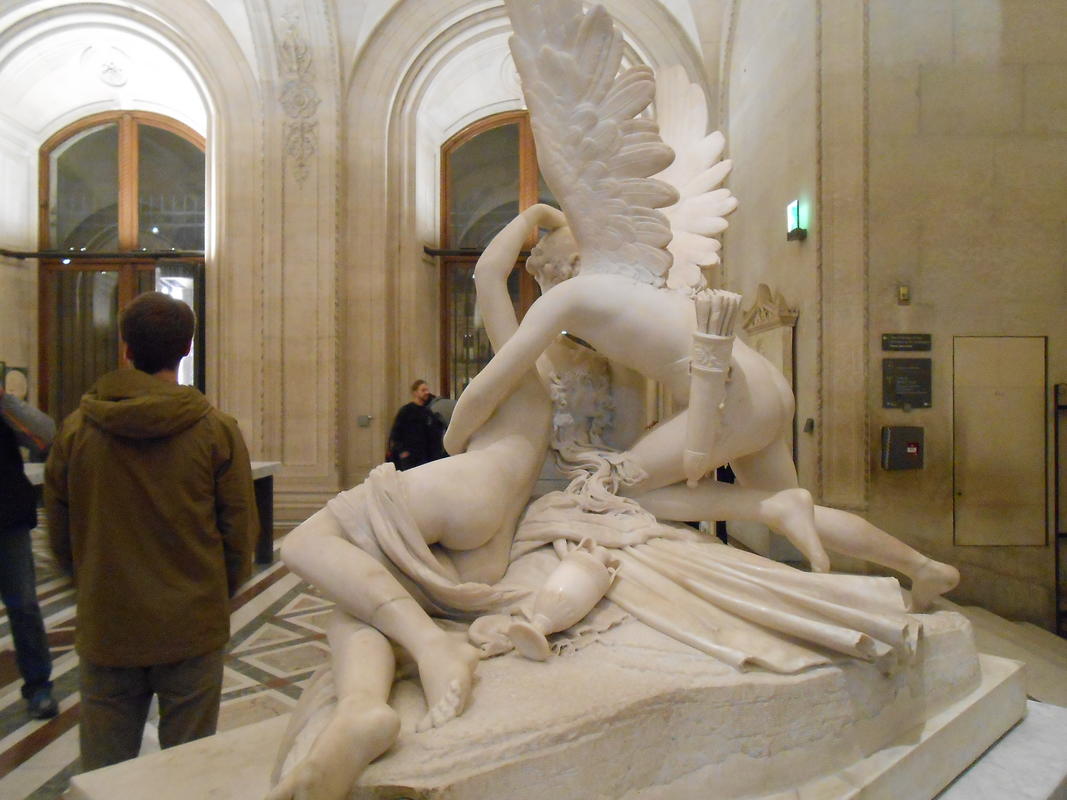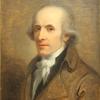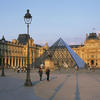More about Psyche Revived by Cupid's Kiss
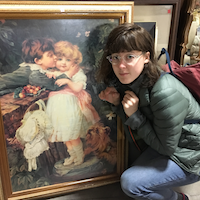
Contributor
Antonio Canova’s Cupid and Psyche may have been the perfect fodder for a horny nobleman wishing to redecorate a palace or two.
Even if it's not the gloriously chubby infant that usually springs to mind when one thinks of mischievous little Cupid, the general public has always smiled upon Canova's tender rendition of a myth that's been depicted more times than there are drapery folds in a Boucher portrait. An unsuitably bleak interpretation by Goya? Check. David's pair of lovers basking in post-coital bliss? You bet. Canova took it up a notch with an angelic rendition that amplified the drama of an "awww" moment to rival the ending of any given rom-com. You won't even miss baby Cupid's undulating fat rolls, I promise.
A painstaking attention to detail suggests that Canova might have lingered a bit too long on the couple’s sensual curves, or perhaps he was eager to please John Campbell, the British politician and army officer who originally commissioned the sculpture. Either way, Canova was a perfectionist with a capital P. He regularly rubbed his work with soot to achieve his signature smooth finish and even garnished this sculpture with a handle, allowing Campbell to spin the pair around like an erotic merry-go-round.
Upon his first glimpse, the French novelist Flaubert proclaimed that he kissed, "the armpit of the swooning woman stretching out her long marble arms to Cupid. And then the foot! The head! Her face! Forgive me,” he stated, “but it was my first sensual kiss for so long; indeed it was something more; I was kissing beauty itself." I guess there weren't any museum guards back then to prohibit visitors getting handsy with the art. In any case, Flaubert wasn’t alone in his passionate reaction to this sculpture―witnessing the two lovebirds in the throes of romantic ecstasy is enough to make any self-respecting bystander eager to slide into first base for a little ménage à trois.
In perhaps the most blatant example of envy gone wrong, Venus (Cupid’s mother) became extremely jealous of a young mortal woman by the name of Psyche, who was recently named the most beautiful woman in the world. As Venus was generally used to being #1 on “Rome’s Hottest” list, she set out to dethrone Psyche and return attention to herself. Her plan backfired when she sent her minion (her son Cupid) to turn Psyche into the most hideous creature on earth. He was so captivated by her beauty that he poked himself with his own arrow, falling madly in love with her and finally abducting her to live with him forevermore.
The catch? He kept his identity on the down low. Psyche bought into the whole "love is blind" thing for a while until one night her curiosity (which almost killed Psyche as quickly as the fabled "cat") urged her to sneak a peak. A scorned Cupid promptly ran out on his beloved, heartbroken by her lack of trust. Because it's not at all understandable that she didn't trust the person who abducted her anonymously and against her will, right? Regardless, Psyche was devastated by his abandonment, likely due to a raging case of Stockholm Syndrome. Meanwhile Venus―still harboring an unrequited need for revenge―left the woman on the brink of death until lover boy valiantly arrived to give her a life-saving smooch, reuniting the two once more.
I think any normal person would say "Thanks, but no thanks" to Cupid's offer to go live happily ever after after that ordeal, but alas, good decisions are rare in Greek Mythology.
Sources
- Adams, Robert M. The Roman stamp: Frame and Facade in Some Forms of Neo-Classicism. Berkeley: University of California Press, 1979.
- Apuleius, Lucius. "Cupid and Psyche." Folklore and Mythology Electronic Texts. February 24, 2015. Accessed July 31, 2017. http://www.pitt.edu/~dash/cupid.html.
- Chipault, Raphaë. "A Closer Look at Psyche Revived by Cupid's Kiss." Psyche Revived by Cupid's Kiss | Musée du Louvre. 2010. Accessed July 31, 2017. http://musee.louvre.fr/oal/psyche/psyche_acc_en.html.
- Ferando, Author: Christina. "Antonio Canova (1757–1822) | Essay | Heilbrunn Timeline of Art History | The Metropolitan Museum of Art." The Met's Heilbrunn Timeline of Art History. July 2016. Accessed July 31, 2017. http://www.metmuseum.org/toah/hd/nova/h
Featured Content
Here is what Wikipedia says about Psyche Revived by Cupid's Kiss
Psyche Revived by Cupid's Kiss (Italian: Amore e Psiche [aˈmoːre e ˈpsiːke]; French: Psyché ranimée par le baiser de l'Amour; Russian: Амур и Психея, romanized: Amúr i Psikhéja) is a sculpture by Italian artist Antonio Canova first commissioned in 1787 by Colonel John Campbell. It is regarded as a masterpiece of Neoclassical sculpture, but shows the mythological lovers at a moment of great emotion, characteristic of the emerging movement of Romanticism. It represents the god Cupid in the height of love and tenderness, immediately after awakening the lifeless Psyche with a kiss. The story of Cupid and Psyche is taken from Lucius Apuleius' Latin novel The Golden Ass, and was popular in art.
Joachim Murat acquired the first or prime version (pictured) in 1800. After his death the statue entered the Louvre Museum in Paris, France in 1824;
Prince Yusupov, a Russian nobleman acquired the 2nd version of the piece from Canova in Rome in 1796, and it later entered the Hermitage Museum in Saint Petersburg. A full-scale model for the 2nd version is in the Metropolitan Museum of Art.
Check out the full Wikipedia article about Psyche Revived by Cupid's Kiss

